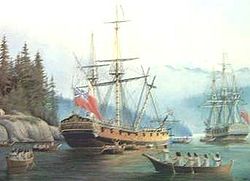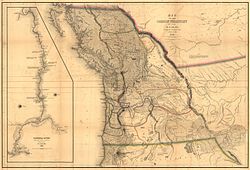Pacific Northwest
The Pacific Northwest, also referred to as Cascadia, is a region on the west coast of North America. It refers to the northwestern corner of the United States and the southwestern part of Canada. The U.S. states of Washington, Oregon, and Idaho are in the southern part of the Pacific Northwest. The Canadian province of British Columbia and the southeast of the U.S. state of Alaska is in the northern part. The entire region is bordered by the Pacific Ocean to the west.
|
Left-right from top: Seattle skyline and Mount Rainier, Multnomah Falls, Crater Lake, Vancouver skyline, the Black Tusk, Cannon Beach, Portland skyline and Mount Hood | |
| Composition |
|
| Largest metropolitan areas | |
| Dialect | Pacific Northwest English |

Historically, the Pacific Northwest had been inhabited by Native Americans. About 15,000 years ago, Native Americans settled along the coastline and along the major rivers. From the 1500s to the 1700s, Europeans explored the region, beginning with the discovery of Oregon and Washington State. In the early 1800s, the famous Lewis and Clark expedition arrived in Washington State. In the 19th century, the region began to be settled. Today, the largest cities in the Pacific Northwest include Vancouver, Seattle, and Portland.
The rugged mountains of the Pacific Northwest consist of the Coast Range, which is nearer the coast, and the Cascade Range. In northern Washington State, the Cascade Range is called the North Cascades. In British Columbia, it is called the Canadian Cascades.[1] The many rivers of the Pacific Northwest result from its wet climate since the mountains trap wet Pacific air and leave little rain for inland states like Idaho. The rivers once supported large salmon runs, but large power dams have been built on many rivers.
The main language of the Pacific Northwest is English in both the United States and Canada. Also, among the Native Americans, Chinook Jargon is common. Among the many Asian immigrants, Chinese is being used more in the Northwest.
Geography
The Pacific Northwest extends from southeastern Alaska to Northern California. Along this entire length is a large mountain range, the Cascade Range, which forms the geographic spine of the Pacific Northwest. The highest mountain is Mount Rainier, at 14,410 feet (4,390 m). Other notable mountains include Mount Shasta, at 14,163 feet (4,317 m), and Mount Baker, at 10,781 feet (3,286 m).
East of the Cascades is the Columbia Plateau, a high area of land that stretches east to the Rocky Mountains in Idaho and Montana. In the west, the Coast Range borders the coast more closely. The Olympic Mountains are on the Olympic Peninsula, an extension of Washington State. Puget Sound is a large system of bays and straits in northwestern Washington State and southeastern British Columbia.
The main rivers of the Pacific Northwest are the Willamette River, Columbia River, Fraser River, and the Snake River. All providing vital influence to the Pacific Northwest climate. The Fraser River is mainly in British Columbia. It flows west to the Pacific Ocean near Vancouver and drains most of the southern Canadian Cascades. The Columbia River begins in the Canadian Cascades, flows south, and turns west, where it meets the Snake River and flows on to the ocean near Portland, Oregon.[3] The Snake River is mainly in inland Idaho. After a journey west from the Rocky Mountains, it meets the Columbia at Kennewick, Washington.
Other rivers in the Pacific Northwest include the Finlay, the Skagit, the Umpqua, the Rogue, and the Klamath. The Finlay drains the northern Canadian Cascades and flows on to join the Mackenzie River, which flows through Canada to Hudson Bay. The Skagit begins in the Canadian Cascades, crosses into Washington, and turns west and flows into the sea north of Everett, Washington. The Umpqua River begins in the Southern Oregon Cascades and flows west to the Pacific Ocean near Reedsport, Oregon. The Rogue parallels the Umpqua and dumps into the sea at Gold Beach, Oregon. The Klamath flows south from a valley in inland Oregon, turns west through northern California, and cutsthrough the Cascade Range to its mouth near Klamath, California.
Pacific Northwest Media
The Pacific Northwest from outer space.
HMS Discovery was the lead ship used by George Vancouver
New Archangel (present-day Sitka, Alaska), the capital of Russian America
U.S. Navy Lieutenant Charles Wilkes' 1841 Map of the Oregon Territory from "Narrative of the United States Exploring Expedition". Philadelphia: 1845
A man in Portland, Oregon with Cascadian flag on International Workers' Day, 2012
Public transportation is used in the Pacific Northwest region. Vancouver's SkyTrain rapid transit system achieves daily ridership of over 500,000 passengers per day on weekdays and the overall transit ridership levels in the Metro Vancouver area rank third in North America per capita.
Related pages
References
- ↑ "Canadian Cascades (Cascade Mountains)". Bivouac - Canadian Mountain Encyclopedia. Retrieved 2009-07-21.
- ↑ "Map of Cascadia". Sightline.org. Retrieved February 19, 2011.
- ↑ "Columbia River". Center for Columbia River History. www.ccrh.org. Retrieved 2009-07-21.














